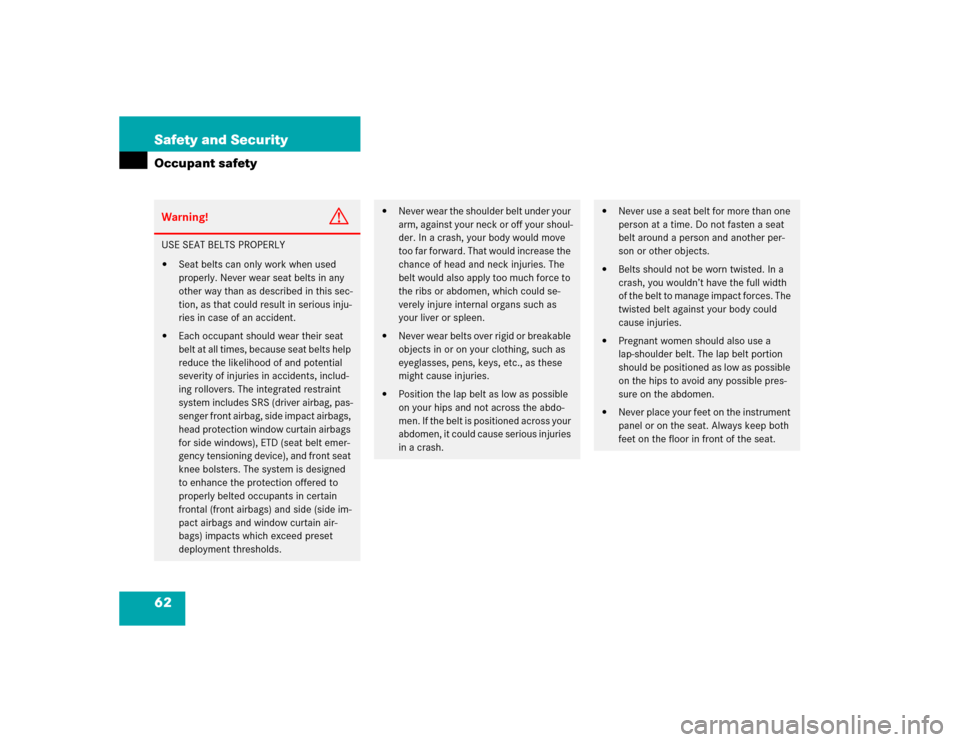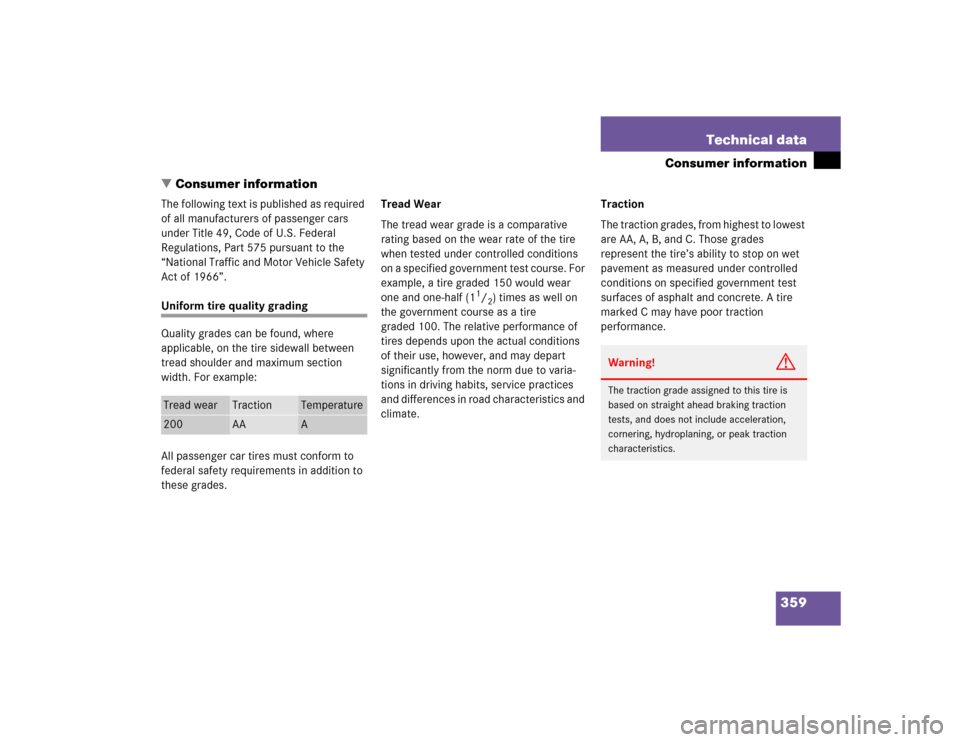Page 62 of 400

62 Safety and SecurityOccupant safetyWarning!
G
USE SEAT BELTS PROPERLY�
Seat belts can only work when used
properly. Never wear seat belts in any
other way than as described in this sec-
tion, as that could result in serious inju-
ries in case of an accident.
�
Each occupant should wear their seat
belt at all times, because seat belts help
reduce the likelihood of and potential
severity of injuries in accidents, includ-
ing rollovers. The integrated restraint
system includes SRS (driver airbag, pas-
senger front airbag, side impact airbags,
head protection window curtain airbags
for side windows), ETD (seat belt emer-
gency tensioning device), and front seat
knee bolsters. The system is designed
to enhance the protection offered to
properly belted occupants in certain
frontal (front airbags) and side (side im-
pact airbags and window curtain air-
bags) impacts which exceed preset
deployment thresholds.
�
Never wear the shoulder belt under your
arm, against your neck or off your shoul-
der. In a crash, your body would move
too far forward. That would increase the
chance of head and neck injuries. The
belt would also apply too much force to
the ribs or abdomen, which could se-
verely injure internal organs such as
your liver or spleen.
�
Never wear belts over rigid or breakable
objects in or on your clothing, such as
eyeglasses, pens, keys, etc., as these
might cause injuries.
�
Position the lap belt as low as possible
on your hips and not across the abdo-
men. If the belt is positioned across your
abdomen, it could cause serious injuries
in a crash.
�
Never use a seat belt for more than one
person at a time. Do not fasten a seat
belt around a person and another per-
son or other objects.
�
Belts should not be worn twisted. In a
crash, you wouldn’t have the full width
of the belt to manage impact forces. The
twisted belt against your body could
cause injuries.
�
Pregnant women should also use a
lap-shoulder belt. The lap belt portion
should be positioned as low as possible
on the hips to avoid any possible pres-
sure on the abdomen.
�
Never place your feet on the instrument
panel or on the seat. Always keep both
feet on the floor in front of the seat.
Page 269 of 400

269 Operation
Vehicle care
Engine cleaning
Prior to cleaning the engine compartment,
make sure to protect electrical compo-
nents and connectors from the intrusion of
water and cleaning agents.
Corrosion protection, such as MB Anticor-
rosion Wax, should be applied to the
engine compartment after every engine
cleaning. Before applying, all control
linkage bushings and joints should be
lubricated. The poly-V-belt and all pulleys
should be protected from any wax.Vehicle washing
Do not use hot water or wash your vehicle
in direct sunlight. Only use a mild car wash
detergent, such as Mercedes-Benz
approved Car Shampoo.
Thoroughly spray the vehicle with a dif-
fused jet of water. Direct only a very weak
spray towards the ventilation intake. Use
plenty of water and rinse the sponge and
chamois frequently.
Rinse with clear water and thoroughly dry
with a chamois. Do not allow cleaning
agents to dry on the finish.
Due to the width of the vehicle, fold in
outside mirrors prior to running the vehicle
through an automatic car wash to prevent
damage to the mirrors.
In the winter, thoroughly remove all traces
of road salt as soon as possible.
When washing the underbody, do not
forget to clean the inner sides of the
wheels.Ornamental moldings
For regular cleaning and care of very dirty
chrome-plated parts, use a chrome
cleaner.
Headlamps, tail lamps, side markers,
turn signal lenses
Use a mild car wash detergent, such as
Mercedes-Benz approved Car Shampoo,
with plenty of water.
To prevent scratches, never apply strong
force and only use a soft, non-scratchy
cloth when cleaning the lenses. Do not
attempt to wipe dirty lenses with a dry
cloth or sponge.
Page 347 of 400
347 Technical data
Main dimensions
�Main dimensions
Model
C 230 Kompressor Sport
C240
C320
C320Sport
Overall vehicle length
178.3 in (4 528 mm)
178.3 in (4 528 mm)
178.3 in (4 528 mm)
Overall vehicle width
68.0 in (1 728 mm)
68.0 in (1 728 mm)
68.0 in (1 728 mm)
Overall vehicle height
56.4 in (1 433 mm)
56.3 in (1 429 mm)
55.6 in (1 411 mm)
Wheelbase
106.9 in (2 715 mm)
106.9 in (2 715 mm)
106.9 in (2 715 mm)
Track, front
58.8 in (1 493 mm)
58.8 in (1 493 mm)
58.8 in (1 493 mm)
Track, rear
57.6 in (1 464 mm)
57.6 in (1 464 mm)
57.6 in (1 464 mm)
Model
C 240 4MATIC
C 320 4MATIC
C32AMG
Overall vehicle length
178.3 in (4 528 mm)
178.3 in (4 528 mm)
Overall vehicle width
68.0 in (1 728 mm)
68.0 in (1 728 mm)
Overall vehicle height
56.0 in (1 422 mm)
56.1 in (1 426 mm)
Wheelbase
106.9 in (2 715 mm)
106.9 in (2 715 mm)
Track, front
58.8 in (1 493 mm)
58.8 in (1 493 mm)
Track, rear
57.6 in (1 464 mm)
58.0 in (1 474 mm)
Page 359 of 400

359 Technical data
Consumer information
�Consumer information
The following text is published as required
of all manufacturers of passenger cars
under Title 49, Code of U.S. Federal
Regulations, Part 575 pursuant to the
“National Traffic and Motor Vehicle Safety
Act of 1966”.Uniform tire quality grading
Quality grades can be found, where
applicable, on the tire sidewall between
tread shoulder and maximum section
width. For example:
All passenger car tires must conform to
federal safety requirements in addition to
these grades.Tread Wear
The tread wear grade is a comparative
rating based on the wear rate of the tire
when tested under controlled conditions
on a specified government test course. For
example, a tire graded 150 would wear
one and one-half (1
1/2) times as well on
the government course as a tire
graded 100. The relative performance of
tires depends upon the actual conditions
of their use, however, and may depart
significantly from the norm due to varia-
tions in driving habits, service practices
and differences in road characteristics and
climate.Traction
The traction grades, from highest to lowest
are AA, A, B, and C. Those grades
represent the tire’s ability to stop on wet
pavement as measured under controlled
conditions on specified government test
surfaces of asphalt and concrete. A tire
marked C may have poor traction
performance.
Tread wear
Traction
Temperature
200
AA
A
Warning!
G
The traction grade assigned to this tire is
based on straight ahead braking traction
tests, and does not include acceleration,
cornering, hydroplaning, or peak traction
characteristics.